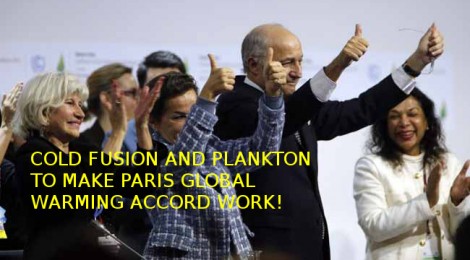
Cold Fusion and Plankton To Rescue Paris Accord!
New Paris Accord commits the world to reducing CO2 emissions by ~30% in coming decades, a seemingly impossible task
We need at least a couple of real miracles
The new Paris Accord agreed to by 195 nations calls for a 30% CO2 emission reduction which will, according to the UN experts, have to come largely from the cessation of burning a vast amount of fossil fuels. Already the dirtiest most CO2 effusive fossil fuels are garnering doomsday predictions in the world media as coal and heavy oils are proclaimed to be all but dead ducks and stranded-assets. Clearly nations, like Saudi Arabia, with vast light oil and natural gas inventories, are acting to lock in security for their nation’s wealth by offering their inventories at low prices. Todays low oil prices, that are at 1970’s-1980’s levels, are evidence of the determined effort to keep them from becoming stranded fossil fuel assets.
While the new Paris Accord (explained here) won’t begin to be realized as a regulated effect for 5 years or more it has started a race to make ‘national commitments’ and act to fill those commitments at as low a cost as possible. The International Energy Agency proclaims that the new Paris Accord will require the spending of $16.5 Trillion between now and 2030! John Kerry of the US government states the number to be spent is $50 trillion! As in all global technological and economic shifts in history those willing and able to invest early will reap the greatest value for their action. The one specific solution technology the Paris Accord states is vital is the expectation of carbon sinks in the form more plant growth, by restoring trees and seas! So the race is on with the winners being those who reach the world’s goal of 30% CO2 control first!
While most of the world focuses of the tremendously difficult task of reshaping societies energy diets by spending that $16.5 -$50 trillion to invent and deploy CO2 sparing technologies two great ‘wild card’ technologies are already standing ready to become the most disruptive technologies the world has ever seen. Enjoyed is perhaps the better word for these technologies as they both offer to solve the 30% CO2 control problem called for by the Paris Accord with far greater reduction potential and at a cost that may simply be “too cheap to meter.”
Twin ‘miracle’ technologies emerged upon the world some 25 years ago as this political cartoon of 1990 clearly shows.
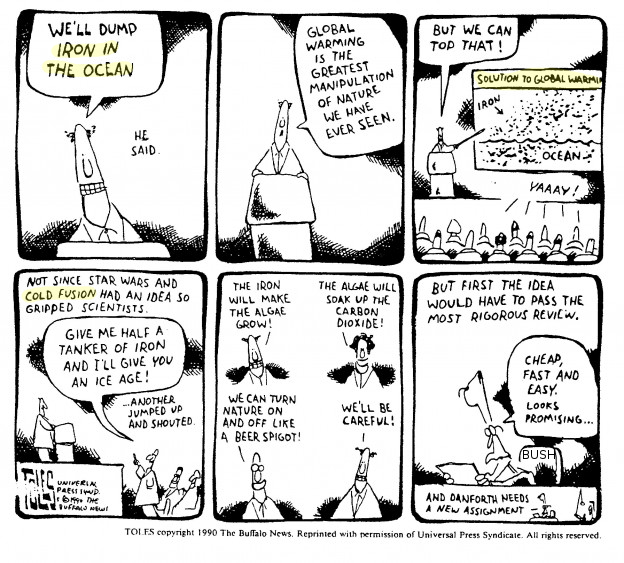
Famed ocean scientist, the late great John Martin, announces his discovery that a half a ship load of iron ore rock dust can save the world from global warming! I’ve done the large commercial global saving scale experiment and can say unequivocably Martin’s numbers were spot on! He made his discovery announcement about the same time famed chemists Martin Fleischmann and Stanley Pons announced their discovery of Cold Fusion!
CO2 Yesterday’s, Today, and Tomorrow’s
All of today’s CO2 problems come from the CO2 we emitted into our air in all of the Yesterdays of our fossil fuel age. Tomorrow’s CO2 will certainly add to the problem but Today’s problems won’t be solved by limiting Tomorrow’s CO2. So let’s get down to first things first.
Today’s primary CO2 impact is seen not as the intensely debated amount of ‘global warming’ that the 45,000 registered delegates to the recent two-week long Paris COP21 meeting attested to. The global warming they were totally focused upon is yet to come. What it will take to hold the amount of future ‘global warming’ to as small amount as possible was the purpose of Paris. 195 nations have signified that it is their intention and agreement to hold tomorrow’s global warming to 2° C and that they will try to keep it down to 1.5° C! They have agreed that myriad measures must begin over the next several decades to work to meet these goals/intentions. All of the measures track back to reduction of CO2 emissions (with other greenhouse gases lumped in as their CO2 equivalent values).
The amount of CO2 emission ‘control’ required to meet the 2° C goal set for 2050 is ~30%. That’s a very large amount. Today, 2015, the world’s total human caused CO2 emissions amount to about 38 billion tonnes every year. All but about 1/3 of that is so far managed by natural processes, by far most of it will be managed by the oceans. If in 2016 we were to meet the 30% reduction target humanity would need to shave ~11 billion tonnes of CO2 off of our yearly emissions and/or facilitate the capture and sequestration of as much as possible. At our status quo natural state that’s nearly 1 day out of every 3 where we would have to live without the use of fossil fuels in any of its forms – no cars, lights, heat, cooking, travel, the list goes on.
Granted the Paris Accord makes meeting our goals entirely voluntary and even offers accommodations for being “flexible” when it comes to honesty of reporting which translates to mean that of course it doesn’t really expect this level of self-control to become the norm until 2050… but it’s a good thing to know what is going to be expected of us all. Well not really all of us as the Paris Accord clearly states that the billion or so people in the rich countries of the world must take care of the lions share of the entire 7 billion human CO2 problem, save the rich folks may and ought to invest $100 billion per year, starting next year, to paying for CO2 control and mitigation technology for the poor folks. (India says it alone needs $250 billion per year in foreign aid if it is to accomplish it’s expected share of CO2 reductions.)

New disruptive technologies are flying into oil markets
I don’t know about you but I for one don’t expect so much of my fellow humankind, I think the majority will take the voluntary $O cost option and let their grandchildren pay for the consequences of their fossil fuel gluttony and ecological avarice. What the world desperately needs are practical affordable solutions today, some like Bill Gates are already preparing for the arrival of a “Black Swan.”
Basic Emergency Medical Triage Rules Are Needed To Guide Us
Think of it this way, its basic medical triage. The story being played out sees one very important patient, let’s call her Mother Nature, having arrived at our emergency room in terrible condition, perhaps even dying. She’s somehow suffered from exposure to a terrible industrial accident where she’s inhaled a massive dose of a dangerous toxic gas (our CO2). We must help her, she is everything to our common home and family.
The proper triage as always is to do the right things for the patient in the right order!
First: Administer the antidote to the poison
Second: Begin treating the most immediate and urgent harm done by the poison
Third: Send the patient (and poison emitters) to counselling so that she/they will learn how to avoid a second lethal exposure.
Delivering the Triage Treatments
First: There is only one antidote to the nearly trillion tonnes of menacing CO2 already emitted into our air over the course of all the yesterdays of our fossil fuel age and that is Mother Nature herself. She can, but only with our help, restore sufficient photosynthesis in her plant life to convert those hundreds of billions of tonnes of our noxious and deadly CO2 into life itself. What we must do is simply help her to restore her trees and seas. To do this we have but a small non-forested part 9% of this earth that supports forests where we can grow some additional trees. At a cost of billions every year we can over time restore sufficient trees to manage a billion tonnes of that menacing CO2.
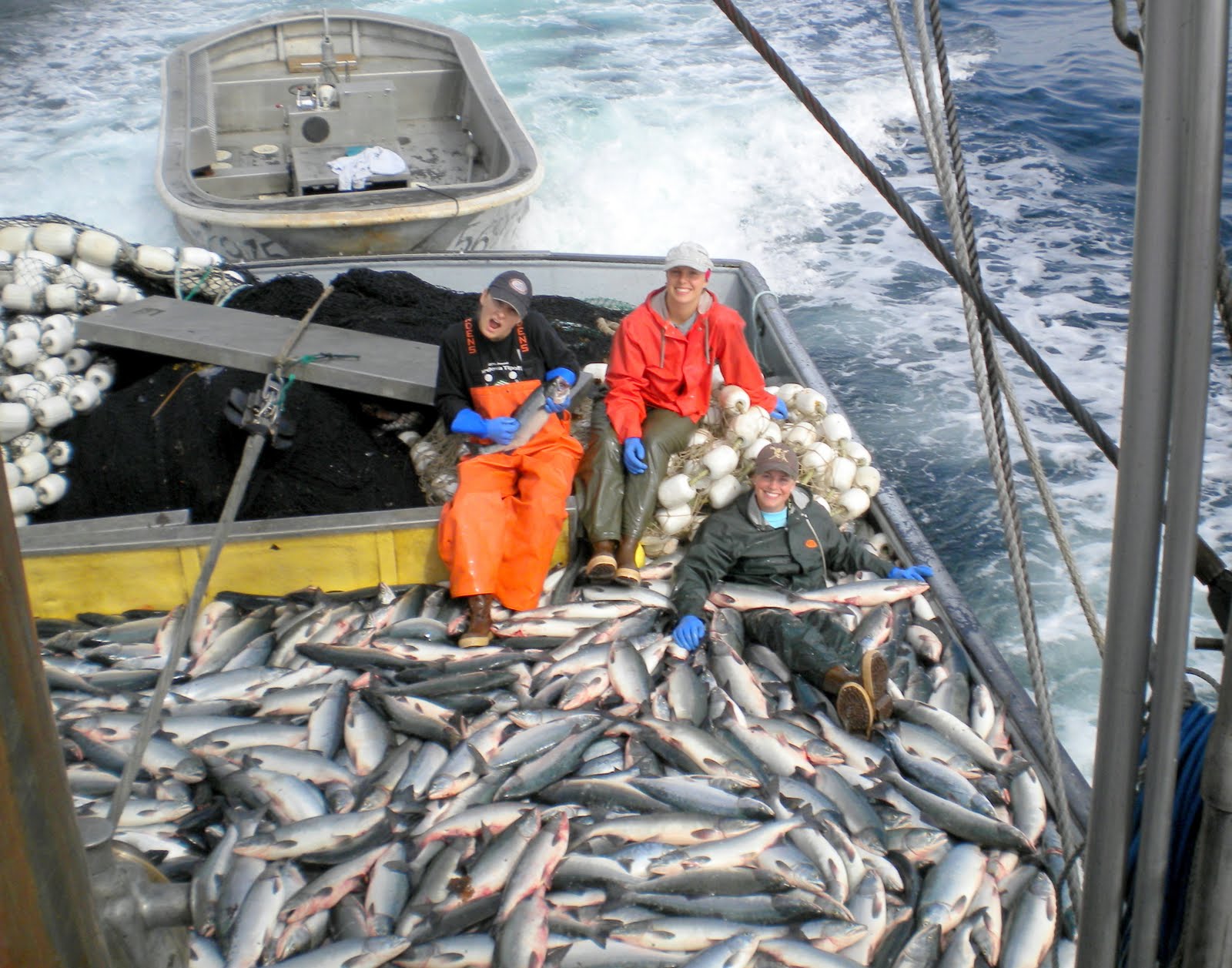
Following my 2012 demonstration restoration of a vital 50,000 sq. km ocean fish pasture in the NE Pacific Alaskan fishers were expecting to catch 50 million salmon. Instead the caught 226 million of the silver beauties, the largest catch in all of history. My ocean pasture repurposed hundreds of millions of tonnes of menacing CO2 into new ocean life! (click image for more)
Some good news is that 79% of this blue planet harbours todays dying ocean pastures and we can restore those ocean pastures so that each year ,at a cost of a few million dollars, ocean plant life revival will repurpose many billions of tonnes of our menacing CO2 into new ocean life. Mother Nature and her twin sister Mother Ocean will in gratitude send us an annual dividend in the form of billions of additional fish to help us end world hunger amongst our fellow humans.
Second: Good news! – If we manage to administer the antidote specified in the first step we accomplish the healing of the harm already done with little or no additional effort on our part!
Third: Avoiding the second lethal dose of CO2 in the future. Here’s where new technologies to eliminate the need to burn fossil fuels become incredibly important. We must have some incredibly dramatic breakthroughs in this as the Paris Accord teaches. But we are up against an entrenched fossil fuel age full of very affordable and very abundant fossil fuels. Fortunately this task and urgency is made more accommodating by the ongoing work of the antidote as in step 1 above. The requirement/goal today is to reduce our emissions by 11 billion tonnes based on present day CO2 emissions.
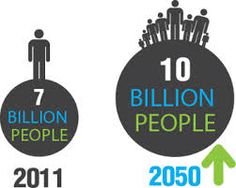 According to the math of the Paris Accord by 2050 our collective emissions will have risen to at least 55 billion tonnes per year, some claim a much higher number. So by 2050 our 30% CO2 control goal in 2050 requires control of 16.5 billion tonnes of CO2 every year.
According to the math of the Paris Accord by 2050 our collective emissions will have risen to at least 55 billion tonnes per year, some claim a much higher number. So by 2050 our 30% CO2 control goal in 2050 requires control of 16.5 billion tonnes of CO2 every year.
That 2050 reduction goal is close to 50% in today’s carbon that our 7 billion strong human race emits. As our population is sure to rise to the 10 billion expected in 205o, those additional 3 billion peole will burn huge amounts of fossil fuels and we individually are facing a very real conundrum.
Traditional alternative energy vs. cheap oil
While most are placing their faith and hopes in development of well established alternative energy sources to replace fossil fuels this is a very difficult uphill battle. First in this battle is the challenge of facing opposition from those nations whose vast oil and gas reserves are their major source of national wealth and well-being. Saudi Arabia and other Gulf oil nations have already shown to have set up a powerful defense of oil and natural gas as a source of energy far into the future by their setting the price of their products back to levels of the 1970’s.
At today’s price of a barrel at $35 dollars these nations cost to produce and deliver all the oil the world can possibly use is still far below the price to produce which some say is as low as a few dollars per barrel. The sheer economic power and potency of cheap oil from reserves capable of delivering all the oil energy the world can consume for decades to come is a force to be reckoned with and is today proving it has the power and will to crush alternative energy competitors. It seems the only energy source priced low enough to stave off the price war of oil is perhaps hydroelectric power.
What this leaves as the competition and replacement for cheap oil are truly ‘out of the box’ disruptive new energy technologies.
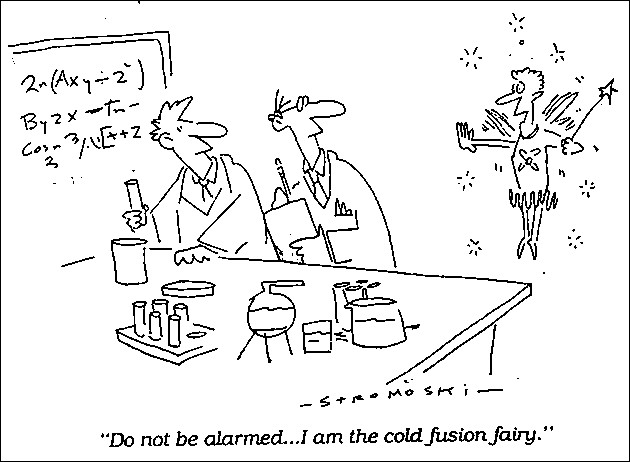
Cold Fusion’s discovery announced in 1989 scared the living daylights out of vast numbers of conventional science workers as it suggested that much of what they had been taught as dogma was to be overturned and along with it the stability of established research and industry.
Top of my list of new disruptive energy technologies is course ‘cold fusion’ known as aka lenr by some. This discovery announced to the world in 1989 rapidly became the whipping boy of conventional nuclear physics and allied science institutions as it was perceived (correctly) to be utterly disruptive to both conventional nuclear physics dogma as well as chemical and energy academia and industry.
The foundation of this cold fusion energy producing reaction is that when the smallest atoms known, hydrogen isotopes, are gently forced into the spaces in-between the large atoms that make up metals therein the hydrogen atoms undergo cold nuclear fusion resulting in a transmutation into a larger single atom. That fusion follows Einstein’s E=mc² rule where the transmutation of matter releases vast amounts of energy.

A metal lattice has lots of room in between metal atoms for tiny hydrogen.
In the case of the unusual “cold fusion’ process the energy release is coupled to the vast number of relatively giant metal atoms and is thus seen in the form of pure heat. Outside of the solid state environment conventional nuclear fusion’s energy is seen in the form of deadly high energy radiation a characteristic unseen in cold fusion.
The fuel for cold fusion is simple hydrogen, the same atoms as are part of every water molecule of water H2O! The energy released in cold fusion of waters hydrogen is thousands of times that found in an equivalent mass of fossil fuel burned.
Today hundreds of scientists around the world are working to deliver cold fusion after more than 25 years of R&D.
Thousands of scientific papers describing their work have been published in peer-reviewed journals and presented at scientific conferences around the world for 25 years. (visit a library of a selection of these papers here) Not surprisingly the competitors and defenders of present day ruling dogma and established energy assets have and continue to mount a powerful misinformation campaign claiming cold fusion/lenr is impossible, against the laws of physics, or even a fraud. But progress in spite of having to fight this seemingly overwhelming opposition has been steady albeit slow. After years of cold fusion inventions and inventors being categorically rejected by the US Patent office in the past several years, and especially this year, cold fusion patents are finally being issued.
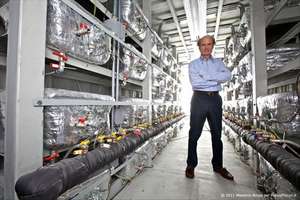
Italian engineer Rossi stands inside one of his megawatt cold fusion power plants like one now online powering a US corporation commercial production line.
Within the next few months several monumental demonstrations of cold fusion at industrial significant scale will be completed. If these, and some are megawatt scale, industrial cold fusion machines prove their worth then the world will see the late Martin Fleischmann’s dream come true and the world will be awash with infinite energy truly too cheap to meter.
Cold fusion produces simple heat it is highly suited to immediate and rapid deployment in factories, power stations, onboard ships and trains, for simple heating applications that presently burn fossil fuels, and in some cases for the production of light.
 The cost to produce practical cold fusion machines is no more than today cost to produce equivalent fossil fuel fired devices they will replace. Some cold fusion devices will be from all appearances very hot light bulbs, heat lamps offering kilowatts of heat with years of fuel built. Of course cold fusion offers the immediate advantage of being fueled with fuel that is thousands of times more cost-effective than fossil fuels it replaces. It will take some years for it to be refined to power small compact forms of transportation like highway vehicles and aircraft.
The cost to produce practical cold fusion machines is no more than today cost to produce equivalent fossil fuel fired devices they will replace. Some cold fusion devices will be from all appearances very hot light bulbs, heat lamps offering kilowatts of heat with years of fuel built. Of course cold fusion offers the immediate advantage of being fueled with fuel that is thousands of times more cost-effective than fossil fuels it replaces. It will take some years for it to be refined to power small compact forms of transportation like highway vehicles and aircraft.
Other out of the box energy technologies might also be on the way!
You can find some reports here on the Atom-Ecology blog and more will come over the next few months as we discover whether the preliminary reports prove out.